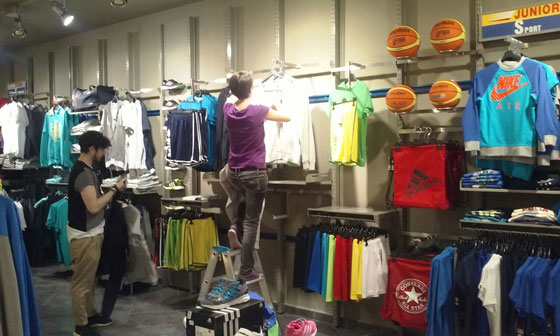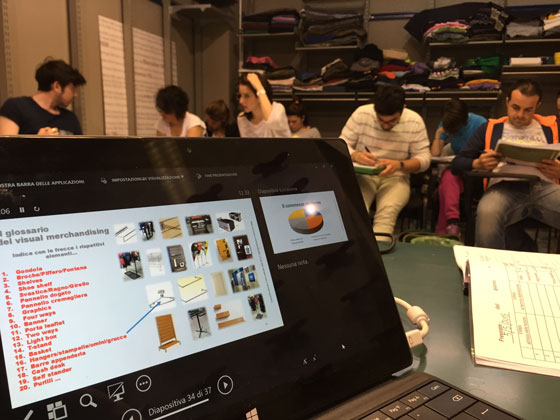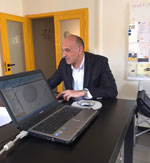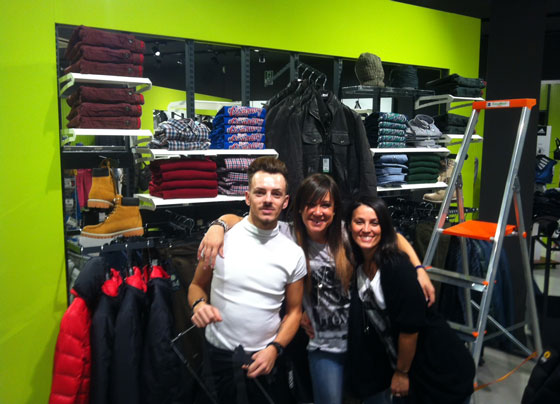
If in the previous issue we played the role of the “retail spies”, this time we have taken our sunglasses and our false moustaches off to dedicate ourselves entirely to our area of expertise as real retail professionals.
We are going to deal with a crucial factor to determine the success of a company: training courses. We often get in touch with businesses featuring good products and promising stores, but it is inevitable to realise that they lack that something special which helps creating an engaging environment able to make clients feel comfortable. That is way training courses should be taken into due consideration: the store, how it is perceived and the staff are the tangible expression of the company, its product offering and the brand essence.

The sales point thus becomes a calling card and an increasing number of companies seek a professional advice to train their staff. Due to its extensive experience in this sector, XT Retail is often asked to take part in many training projects. It is very interesting to analyse the activity performed by XT, given that many different companies have applied to us. The very first step to take before putting a training project into practice is to meet the client and examine some aspects: the aim of the training process, the staff to be trained, the workshops and the exercises to be performed in order to define some key concepts.
Offering training services means fore and foremost to grasp the spirit of the brand you are working for, understand its needs and then design a training programme which reflects such values. The implementation of the course triggers a sort of magic: it lies in the trainer’s ability to realise how the course is turning out during the day, empathise with the group and form a tight team aiming at effective results and positive solutions. We have gathered some experiences to explore in depth what is training about, how it can be managed, what is the expected outcome and who are the participants. We have addressed this topic by comparing some points of view that could complete a general framework featuring many different yet intertwined figures.
ARIANNA ZABEO_ Marketing and Communication Manager at Trops Spa

Does your company invest in training? Why?
Trops invested significantly in training, especially during the first decade of 2000, since it was imperative to stand out as a sound alternative to the growing market of the megastore based on the self-service model. The company mission was to have a professionally trained staff, able to build a relationship with clients with the aim of providing a real consultancy service rather than simply displaying the product. In this way retail assistants can feel themselves as sales professionals. We noticed that some members of the staff and some applicants considered this sector, and in particular this role, as the last resort, as if it was a second-class job. Obviously, this approach had a negative impact on the performances. Qualifying and motivating the personnel, making them acquire specific skills: these are all factors that make the difference. The performances of those who love this job and feel passionate about it, engaging in and considering the sale as an art, have a positive influence on the corporate image, the sales service and, actually, on the turnover.
What are the roles of your staff do you intend to invest in?
First of all, we must point out that Trops pays particular attention to the store and its staff. Our company invests mainly in two functions: the store manager and the retail assistant. In addition to sales skills, the former is also required to have team building abilities: this means being able to build a tight and balanced group, setting clear targets for the results to be achieved, including the turnover, of course. As far as the Store Manager is concerned, another essential requirement is the ability to interact with the company’s members, namely having good managerial skills. Another key function is that of the retail assistant who, with regard to Non Solo Sport, is a real sales consultant. We have analysed our stores and, at the same time, made an overview of the market trends: while many stores currently make extensive use of self-service tools, also taking the size of Non Solo Sport sales points into account we have realised that our strength lies in the specialized skills of the seller, a tailor-made service that makes us unique. It sometimes happens that we do not sell a given product to the customer because we prefer not to provide them with something that is not suitable and does not meet their needs. We aspire to train a consultant who is not only concerned about the sale of the moment, but also about customer satisfaction in a broader sense. Suggesting clients an item with the sole purpose of selling it would not be profitable in view of long-term observations. Moreover, that would not be in line with the image of “Non Solo Sport” that we want to deliver: a “customised” retail service which puts clients first.
What are the objectives of those who take part in a training course?
The starting point of my consideration are our guys who are following a training course organised by XT Retail: the purpose is that of learning a job which, in this specific case, is that of retail consultant or retail assistant. Thanks to these courses, the participants can reach such a level of knowledge and know-how that they can be extremely competitive in the market (mainly in the retailing sector). Thanks to their skills and background they can gain a privileged position compared to other applicants. In a wider sense, we can assert that the main goal, mainly for those who have just completed their studies, is approaching the world of work. But there are also other important objectives: conducting an in-depth study of the sector in which they are being trained, understanding what becoming part of a group, empathy and team dynamics mean and how to organise team work, but above all developing an excellent ability to adapt from the beginning of the training course.

What do participants expect from their trainer?
It is essential that the trainer has followed the same path as the one which the course participants are going to take: the trainer must be aware of each step. Although it is certainly crucial to be trained at an educational level on the topics dealt with during the training programme, on the other hand the fieldwork is another essential requirement. Only by adopting this method, the trainer will be able to impart all those skills which are actually required at work, and thus provide the participants with a truly comprehensive knowledge, so that they can feel more confident when putting the theoretical concepts learned during the course into practice. A practical training is also a winning strategy to empathise with the group that the trainer is going to form.
ELISABETTA DE SANDRE_ HR Manager at Slowear
Does your company invest in training? Why?
In particular, Slowear relies mainly on companies specialising in training (we mention, as a recent example, our new partnership with XT Retail): hence, this kind of training is planned outside the company. All the investments in training are retail-oriented in order to strive to improve the sales force more and more. Ensuring an adequate training means supporting it, so that retail staff does not feel alone when it comes to reach an important goal, such as the ongoing turnover increase.
What are the roles of your staff do you intend to invest in?
As pointed out previously, we tend to train basically two functions in the retailing sector: the Store Manager and the Retail Assistant. The basic training is the same for both and then we diversify the content of the training programmes according to the tasks, the assignments and the goals which must be accomplished by the two profiles during their in-store activities. The Slowear Retail Assistant must be trained as thorough as possible on the selling guidelines. This role should always bear in mind the different steps of the ideal sales process, but above all the target customer with whom he/she will interact in the store. The Retail Assistant should constantly be able to skilfully shift from a formal to a softer approach once a point of contact has been established with the client. The Store Manager, in addition to the features described with reference to the Retail Assistant, is also trained so as to improve leadership and team management skills. Moreover, this function is required to oversee a stage on which we place great emphasis since it is an added value of Slowear: after-sales conflict and claim management.

What are the objectives of those who take part in a training course?
I firmly believe that the participants in a training course primarily aim at learning something new, namely an open-minded attitude that, fore and foremost, will enable them to assimilate new information and knowledge, thus promoting their personal growth. After having received the contents by the trainer, the participants should set themselves another important goal: they should customise said information, process them until giving them a personal touch and, finally, apply them to everyday life in order to implement and share them with the colleagues.
What do participants expect from their trainer?
When we select a trainer, it is essential that, from the very first days of the course, he/she will be able to grab the participants’ attention and raise their interest. As far as Slowear is concerned, I prefer a training course with a mostly pragmatic approach: in my opinion, some important theoretical concepts can be better strengthened thanks to a good deal of practice. During these days, practical implementation and exercises are also a great opportunity to create engagement which, in turn, promotes team building.
ANTONIA CASTELLANI_Project Manager at Solco Srl
How can financial support for training be obtained?

It is very simple to obtain financial support for training, mainly by means of the Interprofessional Funds, namely funds supporting the workers’ training for which the company pays a 0.30% contribution to the Italian National Social Welfare Institution (INPS). These Funds are associative bodies promoted by the most representative Social Partners (Employers’ organisations and trade unions) at a national level. Companies can subscribe only to one Interprofessional Fund and registration to the Fund of their choice can be performed on a voluntary and cost-free basis by simply contacting the company’s employment advisor. The latter will enter in the INPS UNIEMENS Form the initials of the Interprofessional Fund to which the company intends to allocate its 0.30% share and, from that moment onwards, the INPS will deposit the company’s provision directly to the Fund. Thanks to the registration in an Interprofessional Fund, companies can fund professional training and refresher courses free of charge: they just need to submit a training plan and wait for it to be assessed by the Fund. In addition to Interprofessional Funds, the company can fund its workers’ training by means of regional or national calls for bids, even if it takes longer for them to be brought about and the accounting procedures concerning the activities are more complex.
What are the procedures a company should commit to in order to develop training activities?
Once that the company is registered in a Fund, it can activate a training plan in different ways; for example, it can draw money directly from its own Training Account, where provided for by the Interprofessional Funds, and then submit a plan whose value can covered by the amount accrued. If the deposit is not enough to cover the whole training plan, the companies may take part in an international plan funded by a Notice of the Fund System Account: the System Account issues a call for tender to offer some of its resources to the smallest businesses which are not otherwise able to support training programmes. Companies are only required to actually perform the training during the staff working hours: they are asked by the Funds to implement a co-financing procedure according to which employees must by regularly paid while they are attending the training course. The companies which opt for submitting and managing the training plans funded from the account independently must be familiar with the training procedures and conditions to be observed. If the company is not able to submit, manage and report a training plan, or if it must participate in an international plan, the intervention of a training body recognised by the selected Fund will be necessary. Said training body will complete all the formalities concerning the training plan submission, management and reporting.
MASSIMILIANO LOSAPIO_Retail Manager at Gruppo Cisalfa Sport

Does your company invest in training? Why?
The need for training is backed up by a constant desire for growth: training resources means constantly striving for the company’s improvement. Moreover, a company like Cisalfa, which invests in training, wants that this training programme is aimed at developing a common way of thinking, a similar line of reasoning and, in more practical terms, at standardising procedures.
What are the roles of your staff do you intend to invest in?
To date Cisalfa (which has already developed a corporate programme that identifies and regulates all the Selling Guidelines in compliance with the group’s standards) is particularly focused on training oriented towards visual merchandising. The functions of the sales channel that are mostly involved in this process are the Store Manager and Retail Assistants. In both cases we have decided to start from the definition of the Visual Merchandising basic principles and we are sure that, with respect to the other functions, Retail Assistants will be more strongly involved in the more practical and operational stage.
What are the objectives of those who take part in a training course?
I firmly believe that the participants in a training course should, first of all, try to achieve an individual professional growth. Membership in a group also means, once the theoretical contents of the course have been put into practice, striving for a higher professional performance in terms of profitability, and a better organisation at an operational level through an optimised time management. In brief, after having attended a training course, the goal to be set and accomplished by the participants is to deliver maximum output with minimum effort.

What do participants expect from their trainer?
Fore and foremost, sharing the Gruppo Cisalfa standards and the goals to be achieved with the trainer is extremely important. It is precisely for this reason that we have decided to entrust XT Retail with the management of the next training courses: this agency has already followed some of our projects, it already knows our corporate identity, as well as our needs and the features that we require from a trainer. The collaboration with XT and its trainers makes it easier for us to exchange views since they are sector specialists who have started their careers by gaining first-hand experience in the sales point, both as retail assistants and store managers. XT is fully aware of our need to strike the balance between theoretical and practical content since the professional figures to be trained carry out strictly operational tasks. Furthermore, a sound and reliable training programme focused on Visual Merchandising must meet these requirements.

GIULIA NATALIA PARLANGELI_retail assistant-to-be in the Non Solo Sport stores
Before starting this training programme, I feared that I was going to attend a merely theoretical and – let me say it – “sedentary” course, if it had to take place only in the classroom. But, once the course has begun, I felt relieved since I ascertained that there were also many active and dynamic moments thanks to the different exercises which have been planned. The training in the store was undoubtedly the aspect I have appreciated the most: in this way, practical and theoretical lessons were distributed equally, so that we had enough time to assimilate and reflect upon what we have learned. Moreover, since we have dealt with and analysed the Visual Merchandising topic (a totally new concept to me), I found that practical exercises were crucial to fully understand some of the subjects discussed. The choice to let us get some practical experience in the sales point since the beginning, and carry out some course sessions directly in the store made me feel more motivated. I will find it easier to indentify the different operating areas of the store and the various work steps. In my opinion, first of all, this course helped me to feel more confident. I had already worked as shop assistant, but I was not aware of the basic display principles since I had never been provided with this kind of information. I do not want to sound presumptuous, but now I feel I can work as retail assistant for another company and share what I have learned during the course with my new colleagues so that they will take my ideas into account even if I am a recruit. Now, when in my spare time I go shopping, I cannot but observe the shop window display, the lighting and the arrangement of the products in the store. This leads me to think that this course has been a great opportunity mainly for two reasons: in terms of costs, I could never have afforded to pay a course with my own money; moreover, thanks to this training course, I have learned some basic concepts and acquired new skills that will always belong to my professional background. From today, I have that extra oomph.
In order to collect these interviews, we have met some experts who strongly believe in the potential of people and invest the company’s resources in their training and professional development, for the purpose of taking on new staff members or training the existing personnel to provide them with specialised skills. The results of this survey confirm what we, at XT, already knew: the primary goal of a well organised and, as a consequence, successful course is to create engagement and promote empathy within a group of people who, in most cases, have never met before and do not know each other. Trainers must love this job to convey this passion to the participants in a course and strengthen their sense of belonging, so that the latter can understand that, most of the times, a service with an added value plays a fundamental role in ensuring the company’s success.


